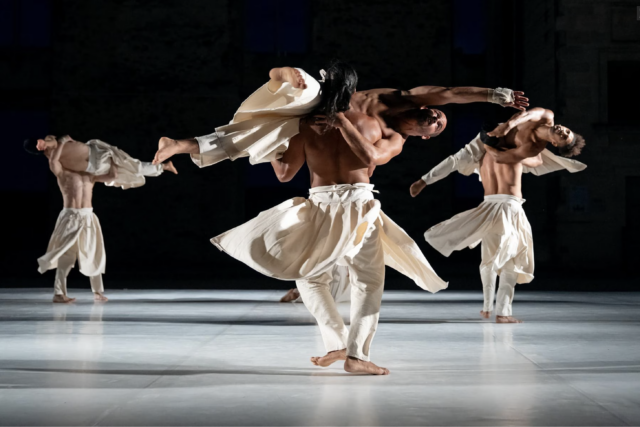
Compagnie Hervé KOUBI brings What the Day Owes to the Night back to the Joyce (photo ©-Didier Philispart)
DANCE REFLECTIONS: WHAT THE DAY OWES TO THE NIGHT
Joyce Theater
175 Eighth Ave. at 19th St.
January 28 – February 2, $12-$82
212-645-2904
www.joyce.org
www.cie-koubi.fr
Last January, French choreographer Hervé Koubi brought down the house at the Joyce with his troupe’s stirring 2023 production, Sol Invictus, so it’s no surprise that Compagnie Hervé KOUBI sold out in advance its encore engagement of 2013’s What the Day Owes to the Night. A later production dazzled Joyce audiences in 2018, and it’s back to once again push the limits of what the human body can do.
In a program note, Koubi, who discovered his family’s Algerian roots when he was twenty-five, explains, “This project is at the crossroads of two preoccupations: my taste for the construction and the danced composition and a deep need to bring me closer to my origins in the land of Algeria. Links to be found, others to be renewed, and still others to be built.” Upon learning of his heritage, he spent four years in Algeria and came back with a movement language that incorporates hip-hop, the Afro-Brazilian martial art of capoeira, break-dancing, gymnastics, ballet, and contemporary dance, performed by an all-male North African ensemble.
The sixty-five-minute presentation is named after the 2008 novel by Yasmina Khadra, the pseudonym of Algerian author Mohammed Moulessehoul; the show does not follow the plot of the romantic drama as much as the feel and setting, structured around the midcentury battle of Mers El-Kebir, the Algerian War for Independence, and the hours in a day.
The insanely talented dancers — Badr Benr Guibi, Giacomo Buffoni, Mohammed Elhilali, Vladimir Gruev, Youssef El Kanfoudi, Abdelghani Ferradji, Oualid Guennoun, Bendehiba Maamar, Nadjib Meherhera, Houssni Mijem, Ismail Oubbajaddi, Matteo Ruiz, and El Houssaini Zahid — are dressed in white cotton pants with panels that swirl and shirts that eventually come off, revealing duly impressive torsos. The flowing costumes are by assistant choreographer Guillaume Gabriel, who also arranged the score, which features Johann Sebastian Bach, Sufi music, and the Kronos Quartet performing songs by Egyptian Nubian musician Hamza El Din, in addition to moments of poetic silence.
The dancers begin in a pile in a far corner, then stir in a hazy, smokey dawn. Over time, as Lionel Buzonie’s lighting gets sharper and brighter, resulting in different shades of shadows on the white floor and, for one section, two dozen golden circles, the men do jaw-dropping head spins; shoot our their arms as if defending themselves; lift up one man high into the sky; and form two groups that each toss a dancer up and others catch him.
They swirl like whirling dervishes, writhe on the floor, and arch and angle their bodies in unison. They run forward and backward, perform cartwheels and diving somersaults, and hold hands in a circle. At one point, twelve men line up on one side and all watch a dazzling solo. At another, they come together and do simultaneous handstands, their bare feet dangling in the air like roots growing out of the earth. They occasionally slow down, most likely to gather their breath before the next action-packed moments.
Part of the Dance Reflections by Van Cleef & Arpels initiative, What the Day Owes to the Night does become a bit repetitive — is it possible for remarkable head spins to become de rigeur? — but it is also utterly thrilling, a unified piece that immerses you in Koubi’s world, radically changed by his discovery of his secret family identity. It will likely make you think about your own ancestors and wonder what beauty might be hidden there.
[Mark Rifkin is a Brooklyn-born, Manhattan-based writer and editor; you can follow him on Substack here.]